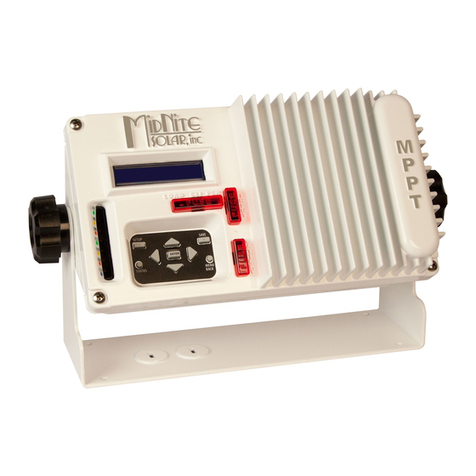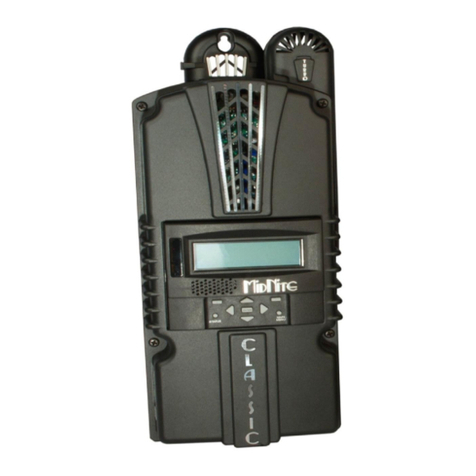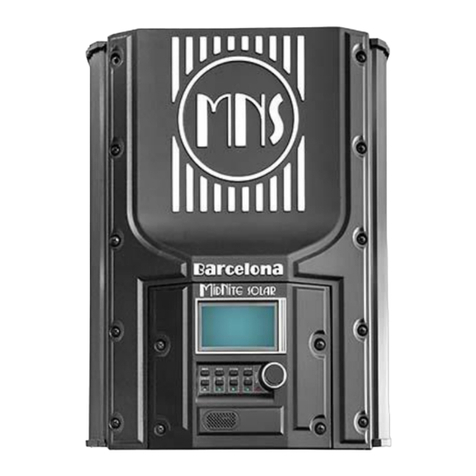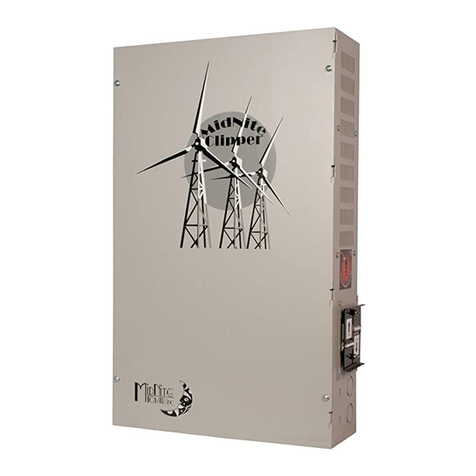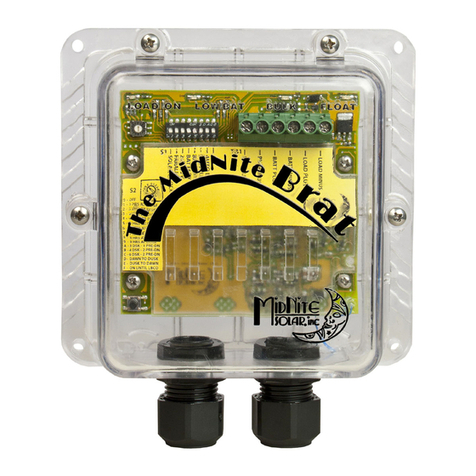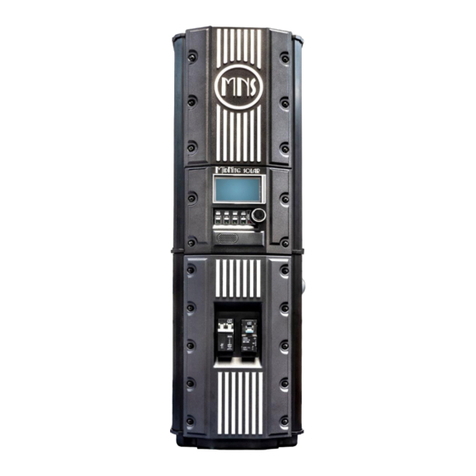
4 | Page 1 0-268-2 REV -
The KID Wind/Hydro Charge Controller Instructions
IMPORTANT SAFETY INSTRUCTIONS
SAVE THESE INSTRUCTIONS
-
THESE INSTRUCTIONS CONTAIN IMPORTANT SAFETY AN OPERATING INSTRUCTIONS FOR
THE KI CHARGE CONTROLLER MO EL NUMBERS
MNKI -HWB, AN MNKI -HWW.
If you do not fully understand any of the concepts, terminology, or hazards outlined in these instructions, please refer installation to a qualified dealer, electrician or
installer. These instructions are not meant to be a complete explanation of a renewable energy system. All installations must comply with national and local electrical
codes. Professional installation is recommended.
ENERAL PRECAUTIONS
:
WORKING WITH OR IN THE VICINITY OF A LEA ACI BATTERY, SEALE OR VENTE IS ANGEROUS. VENTE
BATTERIES GENERATE EXPLOSIVE GASES URING NORMAL OPERATION. FOR THIS REASON, IT IS VERY
IMPORTANT THAT BEFORE SERVICING EQUIPMENT IN THE VICINITY OF LEA -ACI BATTERIES YOU REVIEW AN
FOLLOW THESE INSTRUCTIONS CAREFULLY.
If service or repair should become necessary, contact MidNite Solar Inc. Improper servicing may result in a risk of shock, fire or explosion. To reduce
these risks, disconnect all wiring before attempting any maintenance or cleaning. Turning off the inverter will not reduce these risks. Solar modules
produce power when exposed to light. When it is not possible to disconnect the power coming from the Photovoltaics by an external means such as a
combiner, cover the modules with an opaque material before servicing any connected equipment.
o Not expose to rain or snow. NEVER attempt to charge a frozen battery.
o not smoke around batteries.
When it is necessary to remove a battery, make sure that the battery bank disconnect breaker is in the off position and that the PV breakers, grid
breakers and any other sources of power to the inverter are in the off position. Then
remove the negative terminal from the battery first
.
To reduce risk of battery explosion follow these instructions and those published by the battery manufacturer as well as the manufacturer of any
additional equipment used in the vicinity of the batteries.
Avoid producing sparks in the vicinity of the batteries when using vented batteries. Provide ventilation to clear the area of explosive gases. Sealed AGM
and Gel batteries do not under normal conditions create explosive gases. Refer to the battery manufacturer's documentation. Be especially cautious
when using metal tools. ropping a metal tool onto batteries can short circuit them. The resulting spark can lead to personal injury or damage to the
equipment. Provide ventilation to outdoors from the battery compartment when installing vented batteries such as golf cart T-1 05 batteries. The addition
of a spill tray is also a good idea.
Clean all battery terminals. Very high currents are drawn from the batteries; even a small amount of electrical resistance can result in overheating, poor
performance, premature failure or even fire.
Have plenty of fresh water and soap nearby in case battery acid contacts skin, clothing or eyes. Wear complete eye and clothing protection. Always
avoid touching eyes while working near batteries. If battery acid or battery terminal corrosion contacts skin or clothing, wash immediately with soap and
water. If acid enters the eyes, immediately flood with cool running water for at least 1 5 minutes and get medical attention immediately. Baking soda
neutralizes battery acid electrolyte. Keep a supply near the batteries
o not work alone. Someone should be in the range of your voice or close enough to come to your aid when you work with or near electrical equipment.
Remove rings, bracelets, necklaces, watches etc. when working with batteries, photovoltaic modules or other electrical equipment. Power from an
illuminated photovoltaic array makes a very effective arc welder with dire consequences if one of the welded pieces is on your person.
To reduce the risk of injury, connect only deep cycle lead acid type rechargeable batteries. Other types of batteries may leak or burst, causing personal
injury or damage.
Wiring methods used shall be in accordance with the Canadian Electrical Code, Part I.
Wiring must be done in accordance with the National Electrical Code Article 690 ANSI/NFPA 70. Use Class 1 wiring methods for field wiring connections
to terminals of a Class 2 circuit. Use only 1 4-1 0 gauge AWM wire. Select the wire gauge used based on the protection provided by the circuit
breakers/fuses.
Overcurrent protection must be installed as part of the system installation. Refer to the wiring diagrams provided in
this manual for breaker/fuse/GF I sizes and model numbers.
WARNIN
:
This unit is not provided with a GF I device. This charge controller must be used with an external GF I device as required by the Article
690 of the National Electrical Code for the installation location.
Use of attachments or accessories not approved by MidNite Solar could result in damage or injury.
Before making any connections verify that the circuit breakers are in the off position including the inverter breaker. ouble check all wiring before
applying power.
While every attempt is made to provide accurate documentation, the accuracy of this manual is not guaranteed and may be
updated at any time without notice. Installer assumes all responsibility.
Agency Approvals
The KI is ETL listed to:
UL 1 741
ISSUE:201 0/01 /28 E :2 INVERTERS, CONVERTERS, CONTROLLERS AN INTERCONNECTION
SYSTEM EQUIPMENT FOR USE WITH ISTRIBUTE ENERGY RESOURCES
CSA C22.2#1 07.1 ISSUE : 2001 /09/01 E : 3 (R2011 ) GENERAL USE POWER SUPPLIES.
UL 458
ISSUE :2006/04/1 9 E :5 REV:201 0/03/1 8
UL STAN AR FOR SAFETY POWER CONVERTERS/INVERTERS AN POWER CONVERTER/INVERTER
SYSTEMS FOR LAN VEHICLES AN MARINE CRAFTS.
CSA C22.2#107.2
ISSUE:2001 /11 /01 E : 2 BATTERY CHARGERS GENERAL INSTRUCTION
NO. 1 : 2003/06/01 ; GENERAL INSTRUCTION NO. 2: 2008/1 2/01 - (R2011 )
WARNIN :
EXPLOSION HAZAR . O NOT REMOVE OR REPLACE FUSES
UNLESS POWER HAS BEEN ISCONNECTE OR THE AREA IS KNOWN TO BE FREE OF
IGNITABLE CONCENTRATIONS OF FLAMMABLE GASES OR VAPORS.
WARNIN :
EXPLOSION HAZAR . O NOT ISCONNECT WHILE THE CIRCUIT IS
LIVE OR UNLESS THE AREA IS KNOWN TO BE FREE OF IGNITABLE CONCENTRATIONS.
AVERTISSEMENT:
RISQUE 'EXPLOSION. NE PAS RETIRER NI REMPLACER LES
FUSIBLES À MOINS QUE LA PUISSANCE A ÉTÉ ÉCONNECTÉE OU LA ZONE EST CONNUE
POUR ÊTRE LIBRE ES CONCENTRATIONS IGNOBLES E GAZ OU E VAPEURS
INFLAMMABLES.
AVERTISSEMENT:
RISQUE 'EXPLOSION. NE PAS ÉBRANCHER LORSQUE LE
CIRCUIT N'EST PAS SOUS TENSION OU LA ZONE EST CONNUE POUR ÊTRE LIBRE ES
CONCENTRATIONS IGNOBLES.
Type 1 enclosure for indoor use only
Enclos de Type 1 pour utilisation à l'intérieur seulement.
